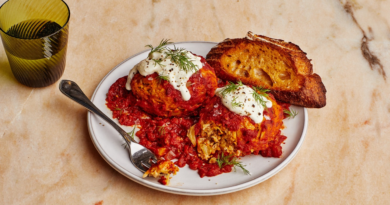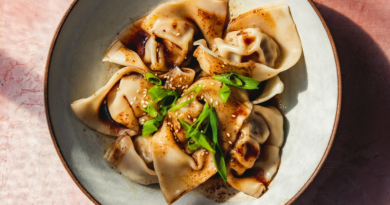BA’s Best Risotto
Step 1
Combine 1 Tbsp. Diamond Crystal or 1¾ tsp. Morton kosher salt and 10 cups water in a medium stockpot. Bring to a boil over high heat; reduce to medium heat and maintain a bare simmer.
Step 2
Meanwhile, heat 6 Tbsp. extra-virgin olive oil in a 6-qt. Dutch oven over medium. Cook ½ large white onion, finely chopped (about 1½ cups) and a pinch of salt, stirring frequently, until onion is translucent and starting to soften, 6–8 minutes. Add ½ cup water and cook, stirring often, until water evaporates and onion is sizzling in oil and completely tender, about 5 minutes. (Adding the water allows the onion to cook gently and thoroughly without taking on any color.) Taste onion; if it’s still firm at all, add another splash of water and continue cooking until meltingly soft.
Step 3
Add 2 cups carnaroli, arborio, or Japanese sushi rice to cooked onions and stir well to coat with oil. Cook, stirring constantly, until grains of rice are translucent around the edges and they make a glassy clattering sound when they hit the sides and bottom of pot, about 5 minutes. Coating the grains with oil before adding any liquid helps the rice cook evenly so that the outside does not become mushy before the center is tender. Add 1 cup dry white wine and another pinch of salt. Bring to a simmer and cook, stirring occasionally, until wine is completely evaporated, about 2 minutes.
Step 4
Reduce heat to medium, then add hot salted water to rice in ¾-cup increments, stirring constantly and allowing liquid to absorb fully before adding more, until rice is al dente and surrounded by fluid, not-too-thick creamy suspension, 25–30 minutes. It should take 2–3 minutes for each addition to be absorbed; if things are moving faster than this, reduce heat to medium-low. Gradual absorption and constant agitation are the keys to cooking risotto, encouraging the starches to release from the rice and transforming into the dish’s trademark creamy consistency. You may not need all of the hot water, but err on the side of soup rather than sludge. The finished texture should be more of a liquid than a solid. Start checking the rice after about 15 minutes; the grains should be tender but not mushy, with a slightly firm center that doesn’t leave a chalky or bitty residue between your teeth after tasting.
Step 5
Remove pot from heat, add 5 Tbsp. unsalted butter, cut into pieces, and stir until melted. Gradually add 1¼ cups Parmesan, stirring until cheese is melted and liquid surrounding risotto is creamy but very fluid. Stir in more hot salted water if needed to achieve the right consistency. Taste and season with salt.
Step 6
Divide risotto among warm bowls. Top each with a grind of pepper. Serve with remaining ½ cup Parmesan alongside for passing.
Photo by Ted + Chelsea Cavanaugh, Food Styling by Simon Andrews
TOPPINGS
BA’s Best Risotto Parmigiano is good enough to serve on its own, but it’s also an excellent canvas for a whole host of toppings. Here are a few options we love, for whatever season you’re in.
Photo by Ted + Chelsea Cavanaugh, Food Styling by Simon Andrews
Spring: Buttered Sugar Snap Pea Risotto With Mint
Heat 4 Tbsp. unsalted butter in a large skillet over medium until foaming, about 1 minute. Add finely chopped white and light green parts of 5 scallions, season with kosher salt and freshly ground black pepper, and cook, stirring occasionally, until scallions are bright green and aromatic, 1–2 minutes. Add 1 lb. sugar snap peas (trimmed, cut in half lengthwise), season again, and cook, tossing occasionally, until crisp-tender, 2–3 minutes. Remove from heat and stir in ½ cup sliced mint leaves. Spoon peas and any pan juices onto BA’s Best Risotto.
Photo by Ted + Chelsea Cavanaugh, Food Styling by Simon Andrews
Summer: Burst Cherry Tomato Risotto
Heat 2 Tbsp. unsalted butter and 2 Tbsp. extra-virgin olive oil in a large skillet over medium until butter is foaming. Add 4 crushed garlic cloves, season with kosher salt and freshly ground black pepper, and cook, stirring occasionally, until garlic is aromatic and starting to brown, 1–2 minutes. Add 2 pints cherry tomatoes and increase heat to medium-high. Cook, tossing frequently and pressing down on tomatoes with a wooden spoon to encourage skins to split, about 5 minutes. Add ½ tsp. red pepper flakes and toss to combine. Taste and season with kosher salt and freshly ground black pepper, if needed. Spoon tomatoes and pan sauce onto BA’s Best Risotto. Drizzle with oil.
Photo by Ted + Chelsea Cavanaugh, Food Styling by Simon Andrews
Fall: Wild Mushroom Risotto With Thyme
Heat ¼ cup extra-virgin olive oil in a large skillet over medium-high until shimmering. Add 1 lb. mushrooms (such as shiitake, crimini, or maitake, trimmed, caps torn into 2″ pieces) and cook, tossing occasionally, until they begin to soften and release some liquid, 3–4 minutes. Season with kosher salt and freshly ground black pepper and cook, tossing occasionally, until deeply browned and tender, 8–10 minutes. Add 5 crushed garlic cloves, 2 Tbsp. unsalted butter, and 4–5 sprigs thyme and cook, tossing occasionally, until garlic softens and butter is golden brown, about 3 minutes more. Remove from heat and add 2 Tbsp. white wine vinegar or fresh lemon juice. Toss to coat, scraping up any browned bits from surface of pan. Pluck out thyme sprigs. Spoon mushroom mixture onto BA’s Best Risotto.
Photo by Ted + Chelsea Cavanaugh, Food Styling by Simon Andrews
Winter: Lemon Risotto With Chives
Stir finely grated zest of 2 lemons, ½ cup thinly sliced chives, and 5 Tbsp. extra-virgin olive oil in a small bowl; season with kosher salt and freshly ground black pepper. As soon as BA’s Best Risotto is done, stir in 3 Tbsp. fresh lemon juice. Spoon lemon-chive mixture onto risotto.
Editor’s Note: BA’s Best Risotto was first printed in March 2019. Head this way for more of our favorite rice dishes →




